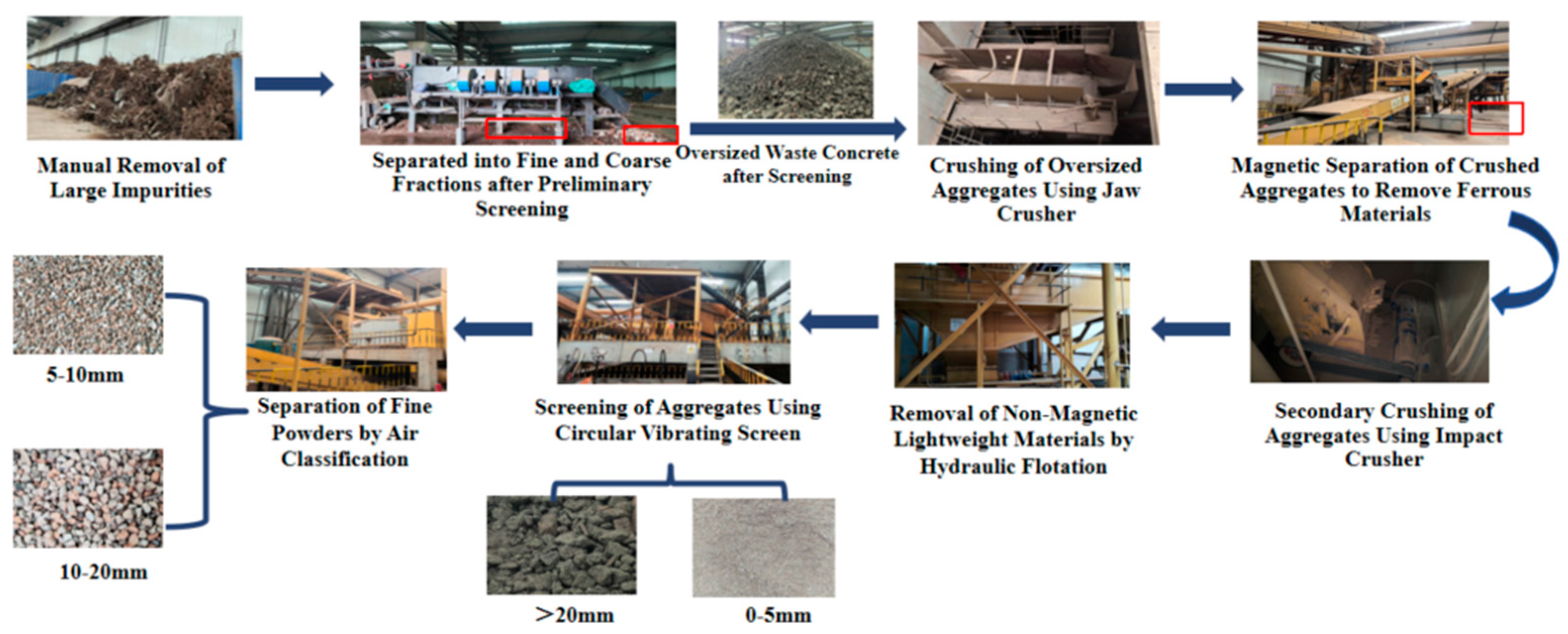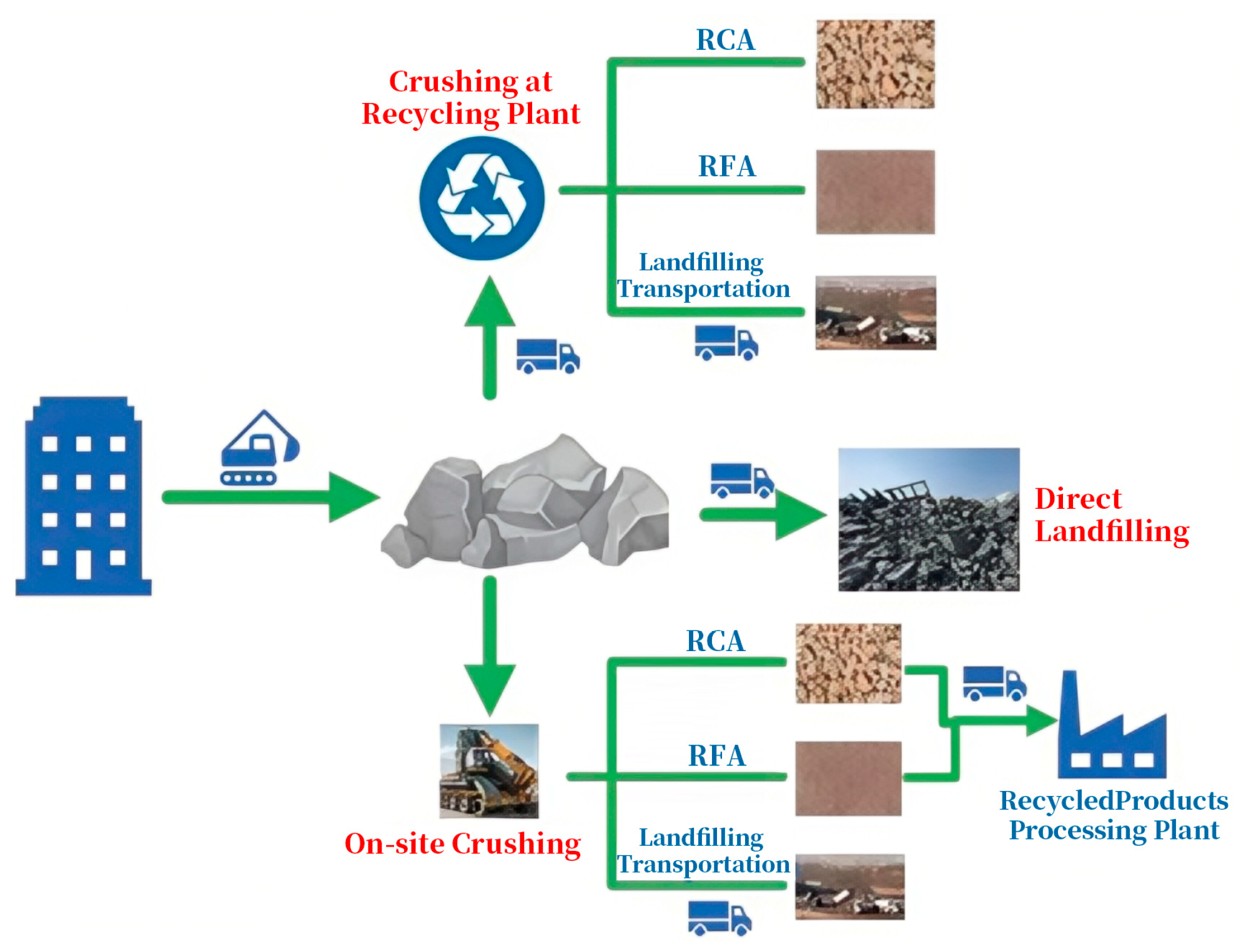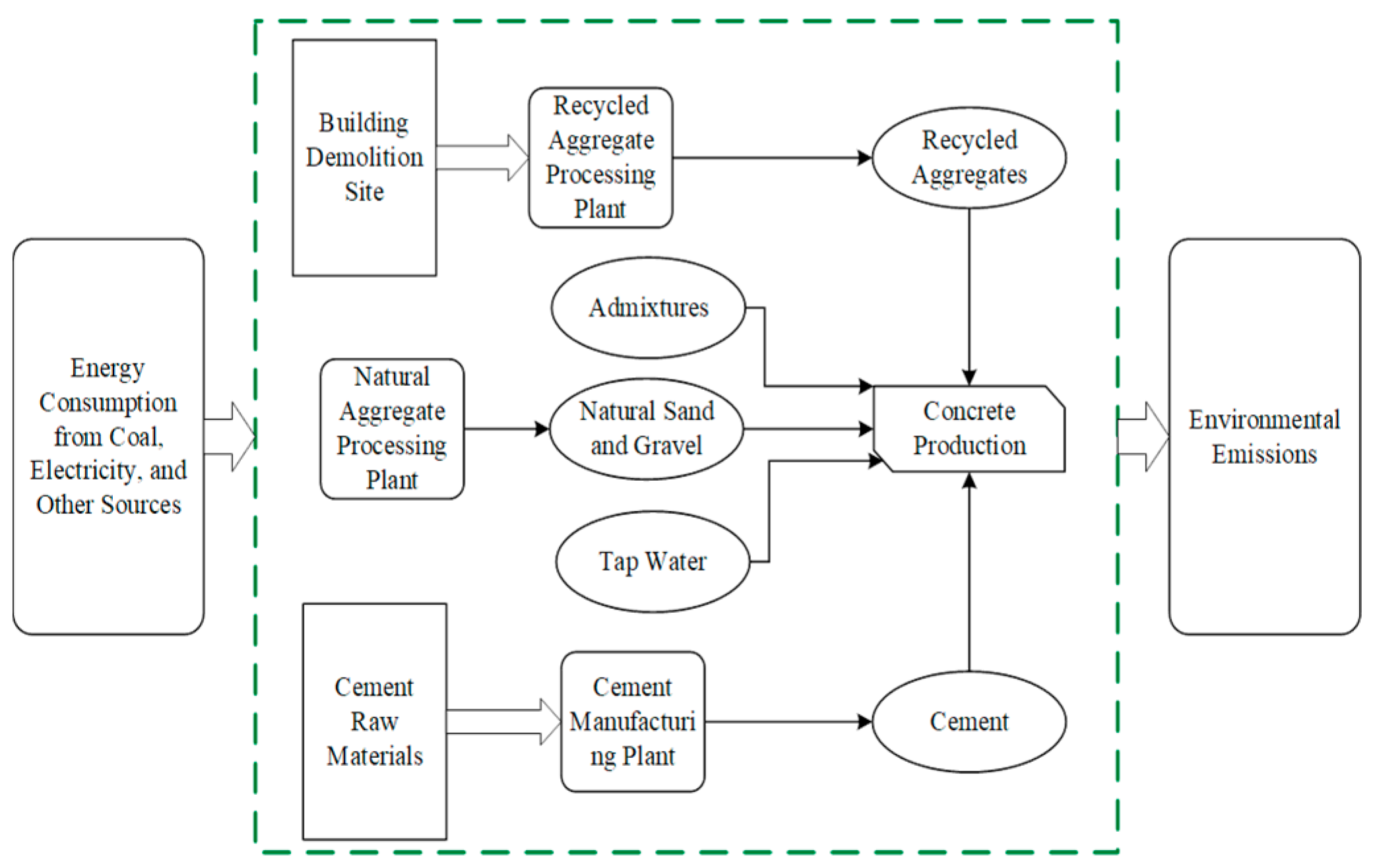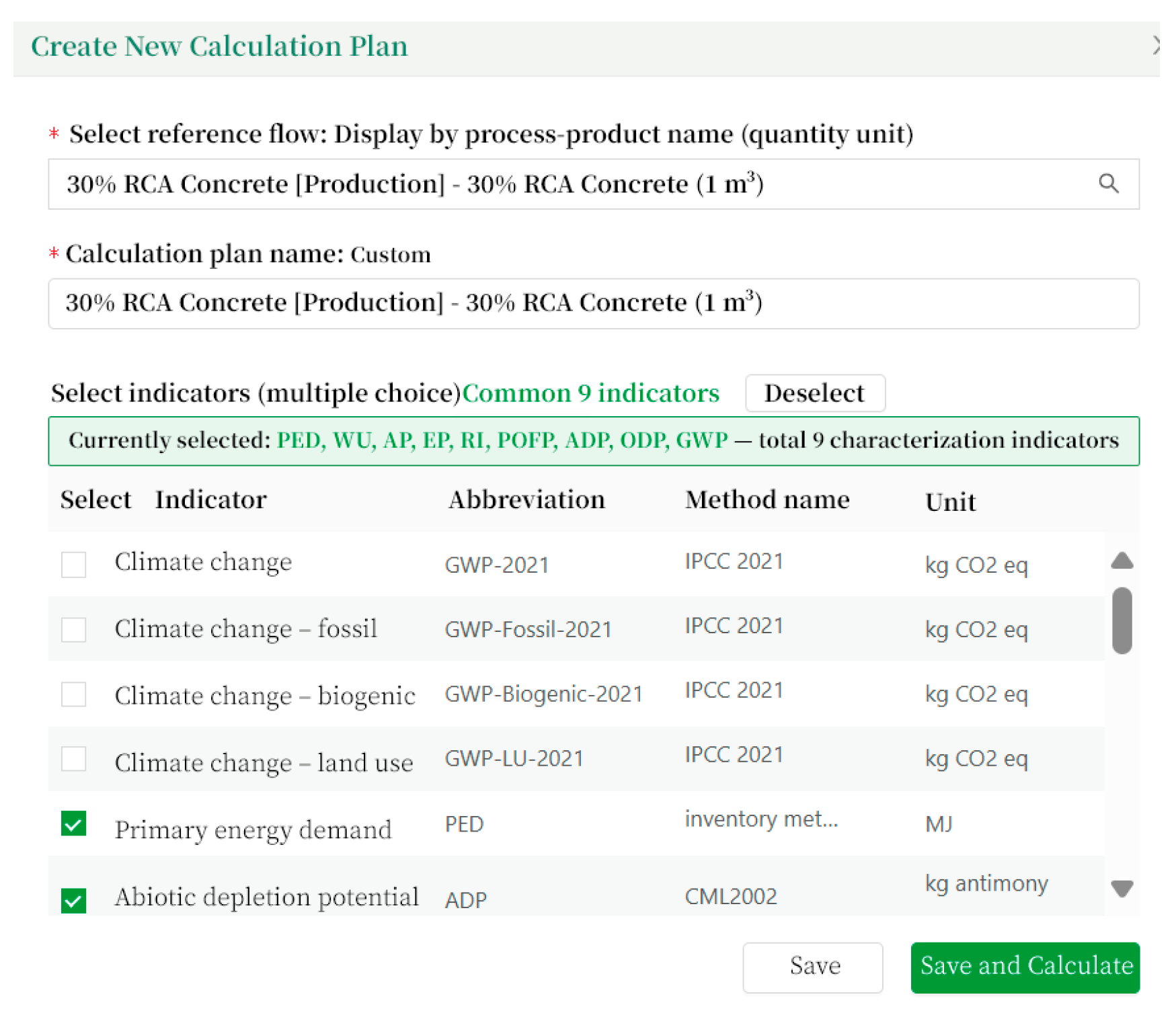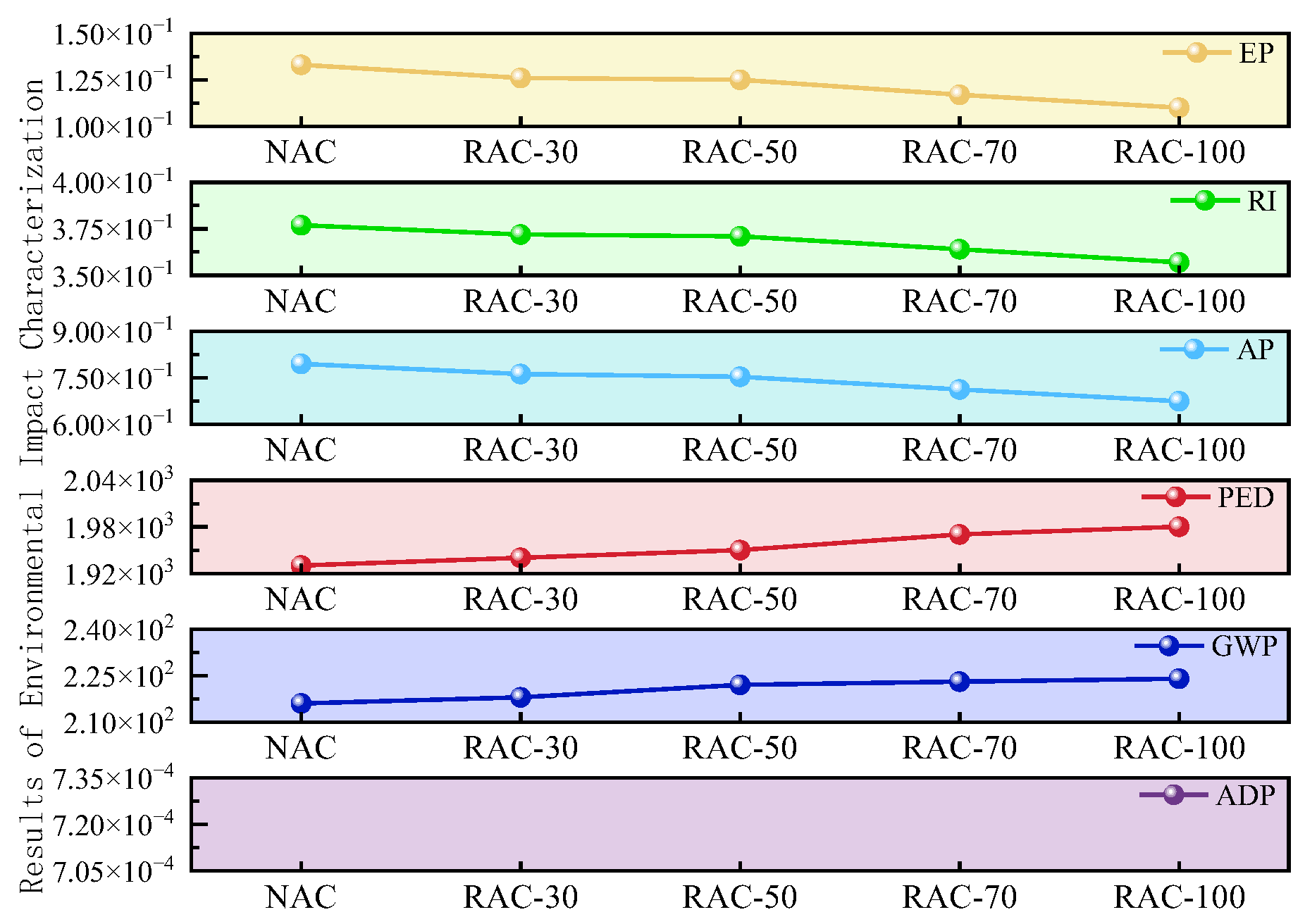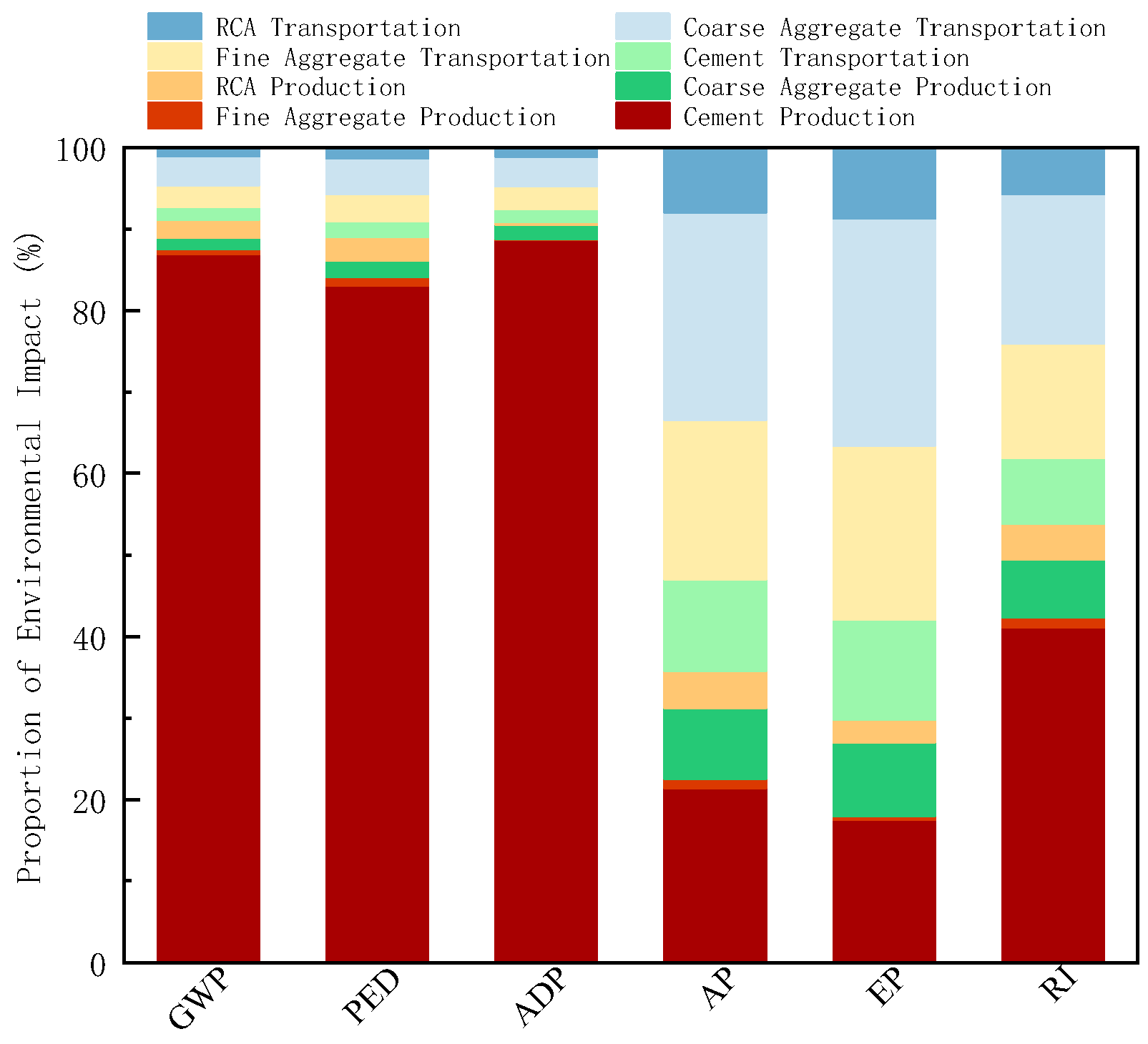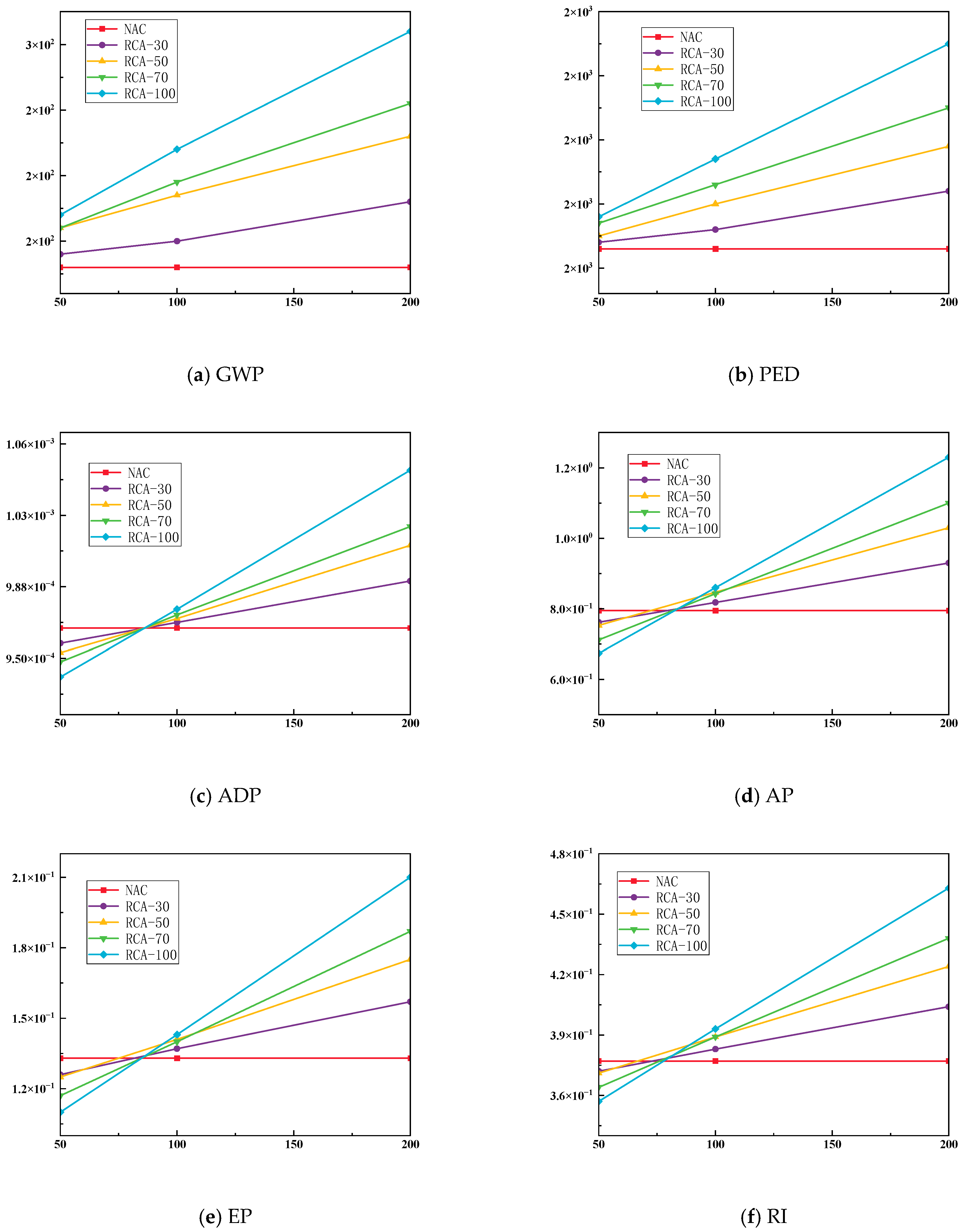1. Introduction
With the accelerating pace in urbanization, the scale of construction activities continues to expand, leading to increasingly severe issues of resource depletion and environmental pollution [
1]. As the most widely used building material, concrete relies heavily on the extraction of natural aggregates and the calcination of cement clinker, making it one of the major contributors to carbon emissions and resource exhaustion in the construction sector [
2,
3]. According to statistics, China generates over 3 billion tons of construction and demolition waste annually, accounting for more than 40% of total municipal solid waste [
4]. However, the resource utilization rate remains below 10%, significantly lower than the average of nearly 90% achieved in developed regions such as the European Union. The traditional disposal method, primarily landfill, is no longer compatible with the goals of ecological civilization and the national “dual carbon” strategy [
5]. Therefore, promoting the recycling of construction waste and accelerating the development of green building materials has become an urgent priority for achieving sustainable development [
6,
7].
Life Cycle Assessment (LCA) is a systematic methodology for evaluating resource consumption and environmental impacts throughout the entire life cycle of a product or process [
8,
9,
10]. It has been widely applied in the environmental analysis of the construction materials industry [
11,
12]. Internationally, the integration of LCA with green building practices began relatively early [
13,
14,
15,
16]. Lawrence et al. [
17] highlighted that the BREEAM framework adopts LCA as one of its core assessment tools, covering all stages of a building’s life cycle, including site selection, design, construction, and operation, while employing a weighting mechanism to quantify environmental burdens. Similarly, Japan’s CASBEE system evaluates environmental performance based on the ratio of environmental load to building quality, emphasizing a systemized scoring approach within the LCA framework [
18]. Guggemos et al. [
19] compared the environmental impacts of office buildings with concrete and steel structures, revealing that the former entails higher energy consumption during the construction phase. In China, efforts have also been made to localize the LCA methodology [
20,
21]. For example, Gong Zhiqi et al. [
22] developed an LCA model tailored to the assessment of building materials and analyzed the environmental loads associated with the production, use, and recycling of common materials such as cement, steel, and PVC.
In recent years, recycled concrete has attracted increasing attention as a green building material due to its potential to partially or fully replace natural aggregates with recycled aggregates derived from construction and demolition waste [
23,
24]. Dilbas et al. [
25] reported that the use of ball-milled recycled aggregates significantly enhanced the strength of recycled concrete by up to 1.54 times. Marinković et al. [
26] compared the environmental impacts of recycled aggregate concrete and conventional concrete, concluding that although both exhibit comparable strength, there is a notable difference in resource consumption. They further found that the environmental impact of recycled aggregate concrete can be higher, depending on the mode and distance of aggregate transportation. Park et al. [
27] evaluated the environmental implications of dry and wet processing methods for recycled aggregate production, showing that the wet process performed worse across multiple indicators and recommending process optimization to maximize environmental benefits. In China, researchers such as Xiao Jianzhuang [
28] have demonstrated through case studies that recycled concrete buildings can reduce carbon emissions by approximately 1.75% compared to conventional buildings, primarily by avoiding the need to transport and landfill construction waste. Nevertheless, a systematic, region-specific, and empirical understanding of the multi-indicator environmental impacts of recycled aggregates under varying replacement ratios and treatment methods remains lacking. Moreover, most existing LCA studies rely heavily on standard databases and theoretical models, with limited integration of real-world engineering data. As a result, current research often fails to capture the localized environmental impact characteristics of recycled concrete.
To address these concerns, this study investigates the environmental impacts of recycled aggregates and recycled aggregate concrete using the Life Cycle Assessment (LCA) approach. An integrated evaluation framework was constructed based on field survey data and implemented through the eFootprint platform, encompassing the entire production chain from raw material sourcing to concrete manufacturing. By designing multiple scenarios with different replacement levels of recycled aggregates, this work conducts a comprehensive analysis of variations in six key environmental indicators: Global Warming Potential (GWP), Abiotic Depletion Potential (ADP), Primary Energy Demand (PED), Acidification Potential (AP), Eutrophication Potential (EP), and Respiratory Inorganics (RI). The results are intended to offer a theoretical foundation and empirical data to guide the green design of recycled concrete, promote efficient resource utilization, and support the development of sustainable solutions for construction and demolition waste management.
The novelty of this study lies in the following features:
Use of a six-indicator LCA framework beyond conventional GWP-only studies;
Incorporation of field-based life cycle inventory data tailored to the Chinese context;
Identification of a transport distance threshold affecting environmental benefits;
Contribution analysis revealing cement and transport as dominant impact sources.
2. Goal and Scope Definition
Life Cycle Assessment (LCA) is a widely adopted methodology for assessing the environmental performance of construction materials. To ensure a structured and comparable analysis, it is essential to clearly define the research objectives, functional unit, and system boundaries before initiating the modeling process. The environmental footprint of recycled concrete spans several interconnected stages—including the treatment of construction waste, the production of recycled aggregates, and concrete manufacturing—each influenced by diverse and complex factors. Therefore, a comprehensive evaluation within a unified framework is vital for accurately capturing the associated environmental burdens. This study adopts the LCA approach to quantitatively evaluate the environmental impacts of recycled aggregates and recycled aggregate concrete across their entire life cycle.
2.1. Goal Definition
In Life Cycle Assessment (LCA), a clearly defined research goal is fundamental for establishing the system boundary, determining the functional unit, and facilitating subsequent analysis. Given the complexity of the production process of recycled concrete—which involves multiple stages and a wide range of influencing factors—a scientifically formulated goal supports the development of a coherent model structure, standardizes data collection procedures, and ensures that the results are both applicable and interpretable.
To improve modeling efficiency and enhance analytical quality, this study adopts a set of assumptions based on the cut-off criteria recommended in the ISO standards:
Materials accounting for less than 1% of the total mass and factors contributing less than 5% to the environmental impact are excluded from the system.
The environmental burdens associated with fixed assets or indirect elements—such as buildings, roads, equipment, and worker lifestyles—are considered negligible.
The upstream environmental impacts associated with industrial by-products such as fly ash and slag are excluded from this analysis.
All concrete is assumed to operate under non-aggressive (non-corrosive) environmental conditions to eliminate variations caused by durability performance.
The depreciation of production equipment is not considered in the assessment.
2.2. Scope Definition
2.2.1. Scope of Recycled Aggregate Assessment
To systematically evaluate the environmental benefits of converting construction waste into recycled aggregates, it is essential to clarify the resource consumption and pollutant emission pathways associated with different disposal methods. This section delineates the assessment scope into two alternative pathways: direct landfilling of construction waste and its recycling. The landfilling pathway primarily encompasses three stages: waste generation, transportation, and final disposal in landfills. In contrast to the former, the recycling pathway encompasses waste generation, transportation, recycled aggregate production, and the landfill disposal of residual materials. The recycling route is further divided into two technological approaches—stationary and mobile recycled aggregate production—based on the processing method employed.
The recycled aggregate data used in this study were obtained from the Zhongcheng Mineral Shenyang Urban Solid Waste Recycling and Green Environmental Industrial Park, located in Shenbei New District, Shenyang, Liaoning Province (as shown in
Figure 1). The facility covers an area of approximately 63,800 square meters and has an annual processing capacity of 1 million tons of construction waste, operating 250 days per year. The relevant production lines have been officially commissioned and are currently in operation, making the facility well suited to meet the representativeness and completeness requirements of life cycle assessment studies.
Field investigations at the aggregate processing facility revealed that the primary raw materials consist of construction and demolition waste originating from building demolitions in Shenyang and its surrounding areas. Most of these structures were built during the 1970s and 1980s and are predominantly brick–concrete constructions. The production process follows a standardized procedure to ensure the stability and representativeness of the recycled aggregate quality. Prior to entering the recycled aggregate processing system, the construction waste undergoes a series of physical sorting, crushing, and screening operations. As illustrated in
Figure 2, the overall process can be divided into several major stages. The red rectangles in the images indicate the coarse, fine, or crushed aggregates corresponding to each processing step.
During the construction waste treatment process, multiple sequential operations are required to ensure the effective separation and purification for producing high-quality recycled aggregates. In the early stage of processing, sizable contaminants like plastics and wood are manually extracted. The remaining waste is conveyed via a vibrating feeder to the primary screening system, where it is sorted into coarse and fine particles according to size. The coarse fraction undergoes initial crushing through a jaw crusher, followed by magnetic separation to remove ferrous impurities such as steel bars and wires. Subsequently, the aggregates undergo secondary crushing in an impact crusher to refine the particle size distribution and improve aggregate uniformity.
To further remove lightweight non-metallic contaminants, the system incorporates a hydraulic flotation unit that separates low-density components such as foam and plastic fragments. After this process, the aggregates are conveyed to a circular vibrating screen, where they are classified into four size ranges: >20 mm, 10–20 mm, 5–10 mm, and 0–5 mm. Finally, the fine aggregates are subjected to air separation to eliminate residual fine particles and lightweight impurities, significantly enhancing their cleanliness and reusability.
While enabling the recycling of construction waste, this process flow also introduces new considerations in terms of energy consumption and carbon emissions. It provides reliable and accurate data to support subsequent life cycle environmental impact assessments. Based on the field investigation, the system boundary for the life cycle assessment of recycled aggregates is defined as shown in
Figure 3.
2.2.2. Scope of Recycled Aggregate Concrete Assessment
This study’s life cycle assessment of recycled aggregate concrete focuses on three key stages: raw material production, transportation, and the mixing and preparation of the final concrete product. The concrete mixture primarily comprises natural sand and gravel, recycled coarse aggregate, water, cement, supplementary cementitious materials, and a small proportion of chemical admixtures. Based on the assumptions outlined in
Section 2.1 and aligned with the defined research objectives and scope, the system boundary for the life cycle analysis was established. A visual representation of this boundary is provided in
Figure 4.
In this study, the concrete strength grade is specified as C30, and a life cycle analysis is conducted on recycled aggregate concrete by varying the replacement ratios of recycled aggregates. The concrete mix proportions are adapted from the research findings of Xiao Jianzhuang et al. [
29], and the detailed mix design is presented in
Table 1.
2.3. Definition of the Functional Unit
In accordance with the ISO 14040 series standards, this study adopts the Life Cycle Assessment (LCA) methodology to quantitatively evaluate the environmental impacts of recycled aggregates and their application in recycled concrete [
30]. To ensure consistency and comparability of the assessment results, two types of functional units are defined respectively:
Functional Unit for Recycled Aggregates: The production of 1 ton of recycled coarse aggregate is selected as the functional unit. Based on a yield rate of 70%, approximately 1.43 tons of construction waste is required to produce 1 ton of recycled aggregate.
Functional Unit for Recycled Aggregate Concrete: One cubic meter of C30-grade concrete is defined as the functional unit.
2.4. Application of the eFootprint Platform
In this study, the eFootprint software platform was employed to model the Life Cycle Inventory (LCI) data and perform environmental impact characterization for recycled aggregates and recycled concrete. The platform complies with the ISO 14044 [
31] international standard for Life Cycle Assessment (LCA) and supports the use of multiple mainstream characterization methods and databases. The environmental impact assessment adopted the CML 2002 midpoint method, which is widely applied in the LCA of building materials. Six environmental impact categories were selected: Global Warming Potential (GWP), Abiotic Depletion Potential (ADP), Primary Energy Demand (PED), Acidification Potential (AP), Eutrophication Potential (EP), and Respiratory Inorganics (RI). These indicators align with the core requirements of EN 15804 [
32] for environmental product declarations (EPD) of building materials and are recognized for their scientific robustness and engineering applicability.
Raw material consumption, energy use, and emission data were normalized based on the functional units of 1 ton of recycled aggregate and 1 m
3 of C30 recycled concrete, respectively, and input into the modeling module of the platform. Under consistent system boundaries, impact categories, and database settings, environmental impact models were constructed for different scenarios. The platform utilizes CLCD 0.9 (Chinese Life Cycle Database) as the background database to ensure regional representativeness of the assessment results.
Figure 5 presents the interface for selecting functional units and environmental indicators within the platform.
In addition, the uncertainty analysis module of the platform was applied to conduct ±10% perturbation tests on key parameters (e.g., cement content and transport distance) to assess their sensitivity to environmental outcomes and to identify major contributing factors. These insights serve as a basis for future environmental optimization strategies. The platform generates both quantitative results and visual outputs, as shown in
Figure 6.
5. Conclusions
This study conducted a comprehensive life cycle assessment of recycled aggregate concrete using six environmental indicators and field-survey-based inventory data. The results indicate that under specific transport distances and replacement rates, recycled aggregate concrete can deliver significant environmental benefits. The main conclusions are as follows:
Compared with conventional landfill disposal, the use of recycled aggregates significantly reduces environmental impacts across most categories. In optimized fixed-plant scenarios, GWP can be reduced by up to 82.27%.
The environmental performance of RAC is highly sensitive to transportation distance. When the transport distance exceeds 60 km, both GWP and PED of RAC surpass those of conventional concrete, indicating a loss of environmental advantage.
There are evident trade-offs among different environmental indicators. Although higher replacement rates may increase GWP and PED due to greater energy consumption during processing, they concurrently reduce ADP, AP, EP, and RI. This underscores the importance of adopting a multi-indicator evaluation approach in environmental decision-making.
Sensitivity and contribution analyses reveal that cement production and transportation are the dominant contributors to most impact categories. Therefore, optimizing material transport routes and reducing transport distances are critical to maximizing environmental benefits.
This study integrates field-survey-based life cycle inventory data and utilizes the China-specific CLCD 0.9 database within the eFootprint platform. This enhances the regional representativeness and reproducibility of the results, distinguishing this work from conventional LCA studies that rely solely on international databases or single-indicator assessments.
The findings of this study offer quantitative evidence to support green construction policies and certification frameworks. Environmental indicators such as GWP and ADP are core components of life cycle-based assessments in rating systems like LEED v4 and BREEAM New Construction. The identification of key environmental hotspots—namely, cement production and transport distance—and the proposed 60 km transport threshold, provides actionable criteria for sustainable material sourcing and Environmental Product Declarations (EPDs). These insights can assist in shaping local green building standards and procurement strategies.
In conclusion, recycled aggregate concrete demonstrates substantial environmental advantages when applied under appropriate logistical conditions and with careful consideration of trade-offs across multiple impact categories. The methods and results presented in this study contribute a practical, data-driven foundation for advancing low-carbon strategies and the responsible use of recycled materials in the construction sector.

